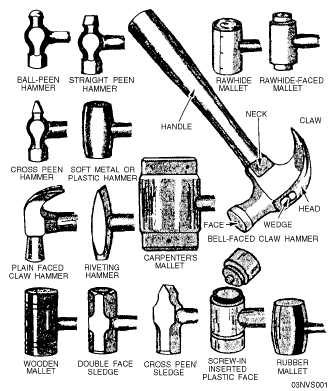NEEDLE-NOSE PLIERS
Needle-nose pliers (fig. 1-47, view B) are used in
the same manner as duckbill pliers. However, there is a
difference in the design of the jaws. Needle-nose jaws
are tapered to a point, which makes them adapted to
installing and removing small cotter pins. They have
serrations at the nose end and a side cutter near the
throat. Needle-nose pliers may be used to hold small
items steady, to cut and bend safety wire, or to do
numerous other jobs that are too intricate or too difficult
to be done by hand alone.
NOTE
Duckbill
and
needle-nose
pliers
are
especially delicate. Care should be exercised
when using these pliers to prevent springing,
breaking, or chipping the jaws. Once these
pliers are damaged, they are practically
useless.
WIRE-TWISTER PLIERS
Wire-twister pliers (safety wire pliers) (fig. 1-47,
view C) are three-way pliers: they hold, twist, and cut.
They are designed to reduce the time used in twisting
safety wire on nuts and bolts. To operate, grasp the wire
between the two diagonal jaws, and the thumb will
bring the locking sleeve into place. A pull on the knob
twirls the twister, making uniform twists in the wire.
The spiral rod may be pushed back into the twister
without unlocking it, and another pull on the knob will
give a tighter twist to the wire. A squeeze on the handle
unlocks the twister, and the wire can be cut to the
desired length with the side cutter. The spiral of the
twister should be lubricated occasionally.
MAINTENANCE OF PLIERS
Nearly all sidecutting pliers and diagonals are
designed so that the cutting edges can be reground.
Some older models of pliers will not close if material is
ground from the cutting edges. When grinding the
cutting edges, never take any more material from the
jaws than is necessary to remove the nicks. Grind the
same amount of stock from both jaws.
NOTE
When jaws on pliers do not open enough to
permit grinding, remove the pin that attaches
the two halves of the pliers, so that the jaws can
be separated.
The serrations on the jaws of pliers must be sharp.
When they become dull, the pliers should be held in a
vise and the serrations recut by using a small
three-corner file.
Pliers should be coated with light oil when they are
not in use. They should be stored in a toolbox in such a
manner that the jaws cannot be injured by striking hard
objects. Keep the pin or bolt at the hinge just tight
enough to hold the two parts of the pliers in contact, and
always keep the pivot pin lubricated with a few drops of
light oil.
REVIEW QUESTIONS
Q14.
Identify the different types of pliers.
Q15.
What are wrench pliers used for?
Q16.
What are side-cutting pliers used for?
Q17.
What is used to sharpen the serrations on the
jaws of pliers?
STRIKING TOOLS
LEARNING OBJECTIVES: Identify the
different types of striking tools. Describe the
uses of different types of striking tools.
Describe the proper care of striking tools. List
the safety precautions that apply to striking
tools.
Hammers, mallets, and sledges are used to apply a
striking force. The tool you select (fig. 1-48) will
depend upon the intended application.
1-30
Figure 1-48.—Hammers, mallets, and sledges.

